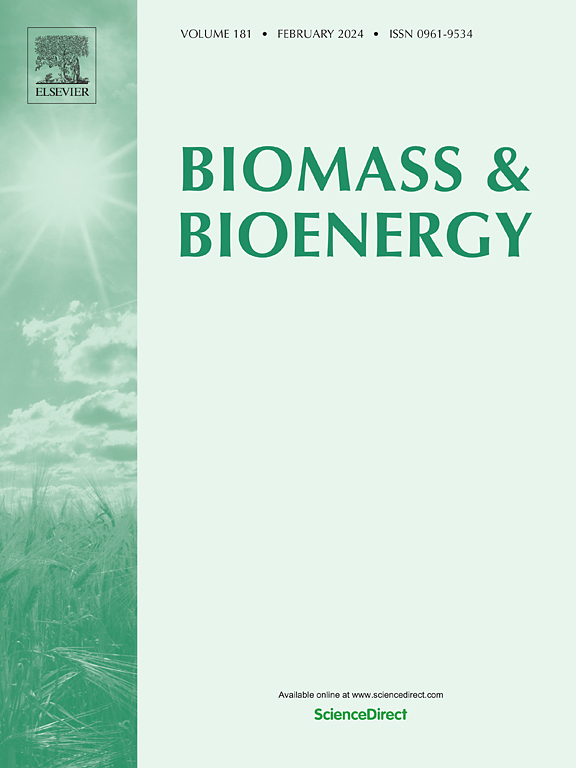Oxidative depolymerization of lignin through biphasic system for enhanced monomer yields and improved valorization
IF 5.8
2区 生物学
Q1 AGRICULTURAL ENGINEERING
引用次数: 0
Abstract
The oxidative depolymerization of lignin is a crucial step toward its valorization, but conventional single-solvent systems often suffer from low monomer yields and extensive repolymerization. This study explores the use of biphasic solvent systems composed of ethyl acetate/water and n-butanol/water to overcome these challenges. Under optimized conditions, the ethyl acetate/water system at 90 °C, 1.0 MPa oxygen pressure, and a 2 h reaction time achieved a monomer yield of 10.12 wt%. The improved performance was attributed to the hydrolysis of ethyl acetate under acidic conditions, enhancing lignin solubility and liquefaction. In comparison, the n-butanol/water system, operated at 150 °C and under similar oxygen pressure and reaction time, yielded 6.65 wt% monomers. The higher boiling point and hydrogen-bonding ability of n-butanol facilitated effective cleavage of lignin linkages. Both biphasic systems provided selective extraction of intermediates into the organic phase, minimizing repolymerization and stabilizing reactive intermediates. The results highlight the effectiveness of biphasic solvent systems in significantly enhancing monomer yields compared to single-solvent systems. This study offers valuable insights into optimizing solvent compositions and reaction conditions for more efficient lignin depolymerization, contributing to sustainable lignin valorization strategies.
木质素氧化解聚双相体系提高单体收率和改善价化
木质素的氧化解聚是实现木质素活化的关键步骤,但传统的单溶剂体系往往存在单体产率低和再聚合广泛的问题。本研究探索了使用由乙酸乙酯/水和正丁醇/水组成的双相溶剂体系来克服这些挑战。在优化条件下,乙酸乙酯/水体系在90℃、1.0 MPa氧压、2 h反应时间下单体收率为10.12 wt%。性能的提高是由于乙酸乙酯在酸性条件下水解,提高了木质素的溶解性和液化性。相比之下,正丁醇/水体系,在150°C、相似的氧压和反应时间下,产率为6.65 wt%。正丁醇较高的沸点和氢键能力有利于木质素键的有效裂解。两种双相体系都能选择性地将中间体萃取到有机相中,最大限度地减少再聚合并稳定活性中间体。结果表明,与单溶剂体系相比,双相溶剂体系在显著提高单体收率方面的有效性。该研究为优化溶剂组成和反应条件以实现更有效的木质素解聚提供了有价值的见解,有助于可持续的木质素增值策略。
本文章由计算机程序翻译,如有差异,请以英文原文为准。
求助全文
约1分钟内获得全文
求助全文
来源期刊

Biomass & Bioenergy
工程技术-能源与燃料
CiteScore
11.50
自引率
3.30%
发文量
258
审稿时长
60 days
期刊介绍:
Biomass & Bioenergy is an international journal publishing original research papers and short communications, review articles and case studies on biological resources, chemical and biological processes, and biomass products for new renewable sources of energy and materials.
The scope of the journal extends to the environmental, management and economic aspects of biomass and bioenergy.
Key areas covered by the journal:
• Biomass: sources, energy crop production processes, genetic improvements, composition. Please note that research on these biomass subjects must be linked directly to bioenergy generation.
• Biological Residues: residues/rests from agricultural production, forestry and plantations (palm, sugar etc), processing industries, and municipal sources (MSW). Papers on the use of biomass residues through innovative processes/technological novelty and/or consideration of feedstock/system sustainability (or unsustainability) are welcomed. However waste treatment processes and pollution control or mitigation which are only tangentially related to bioenergy are not in the scope of the journal, as they are more suited to publications in the environmental arena. Papers that describe conventional waste streams (ie well described in existing literature) that do not empirically address ''new'' added value from the process are not suitable for submission to the journal.
• Bioenergy Processes: fermentations, thermochemical conversions, liquid and gaseous fuels, and petrochemical substitutes
• Bioenergy Utilization: direct combustion, gasification, electricity production, chemical processes, and by-product remediation
• Biomass and the Environment: carbon cycle, the net energy efficiency of bioenergy systems, assessment of sustainability, and biodiversity issues.
 求助内容:
求助内容: 应助结果提醒方式:
应助结果提醒方式:


